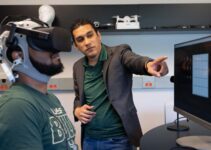POLYN’s NASP Chip, displayed atop of a phone for size comparison. Photo courtesy of POLYN Technology
Opinions expressed by Digital Journal contributors are their own.
At the heart of the artificial intelligence revolution lies the concept of neural networks. Essentially, neural networks are a method of computing information that attempts to replicate the intricate workings of the human brain. Traditionally, computers operated on what was known as the von Neumann architecture, processing information in a linear, sequential manner. However, as the complexity of tasks grew, it became apparent that this approach was insufficient.
To address this limitation, the computing industry began transitioning towards parallel computing, mirroring the parallel processing of the human brain. While some companies have excelled in parallel computing for specific applications like video processing, the broader goal is for computers to behave more like humans in recognizing patterns and responding to stimuli.
While some companies may struggle to match the power efficiency of analog processing, others may find it difficult to adapt their business models to the unique requirements of neuromorphic computing. Furthermore, the ability to customize solutions for specific applications, such as smart tire monitoring in the automotive industry, can be a significant competitive advantage.
POLYN Technologies, a fabless semiconductor company specializing in developing application-specific Tiny AI chips for sensor data pre-processing, stands at the forefront of this transition with its pioneering work in neuromorphic computing. Recognizing the inherent power inefficiency of traditional computing methods, POLYN set out to revolutionize the industry by decreasing power consumption and data throughput. Their approach centers around analog processing, aligning more closely with the brain’s natural computation methods.
One of the primary risks facing POLYN’s competitors is their reliance on outdated digital processing approaches, which are increasingly inefficient in power consumption. As the semiconductor industry moves towards analog processing, POLYN’s neuromorphic approach positions them at the forefront of innovation.
In contrast to cloud-based AI, which relies on centralized data processing in large data centers, edge AI brings computational power closer to the data source, enabling real-time processing and decision-making. POLYN’s focus on edge computing aligns with this trend, offering solutions tailored to specific applications that significantly improve efficiency and performance compared to traditional cloud-based approaches. POLYN’s innovative product lineup includes VibroSense, NeuroVoice, and NeuroSense each designed to address specific challenges in various industries.
VibroSense is an ultra-low-power neuromorphic front-end chip designed for vibration analysis. It addresses the significant challenge of Industrial IoT by preprocessing vibration data at the sensor level. VibroSense enables real-time monitoring of road and tire conditions, enhancing safety and control for vehicles equipped with its technology. By reducing data volume while maintaining accuracy, VibroSense makes vibration-based condition monitoring more accessible and cost-effective on a global scale.
NeuroVoice, another tiny AI chip powered by neuromorphic analog signal processing, targets challenges in mass-market hearables. It offers solutions for voice activity detection, smart voice control, and voice extraction, all while consuming ultra-low power. NeuroVoice enables efficient voice recognition in noisy environments without cloud connectivity, making it suitable for a wide range of applications such as earbuds, wearables, IoT devices, and smart home systems.
NeuroSense, the third product in POLYN’s lineup, is an ultra-low-power neuromorphic front-end chip tailored for wearables. It tackles common issues such as power consumption and heart rate monitoring accuracy, but most importantly allows for continuous, around the clock, monitoring, which other solutions simply cannot offer. By leveraging neuromorphic analog signal processing, NeuroSense offers increased accuracy in heart rate monitoring and advanced functionality for recognition of various human activities. Its capabilities enable mass-market wearables to be always-on, low-power, accurate, and independent of cloud connectivity.
By combining advanced AI technologies with ultra-low power consumption, POLYN has redefined computing and reshaped the trajectory of various industries. Through products tailored for wearables, hearables, and industrial IoT applications, POLYN has not only anticipated market needs but also set the standard for edge computing solutions. To learn more, visit polyn.ai.


